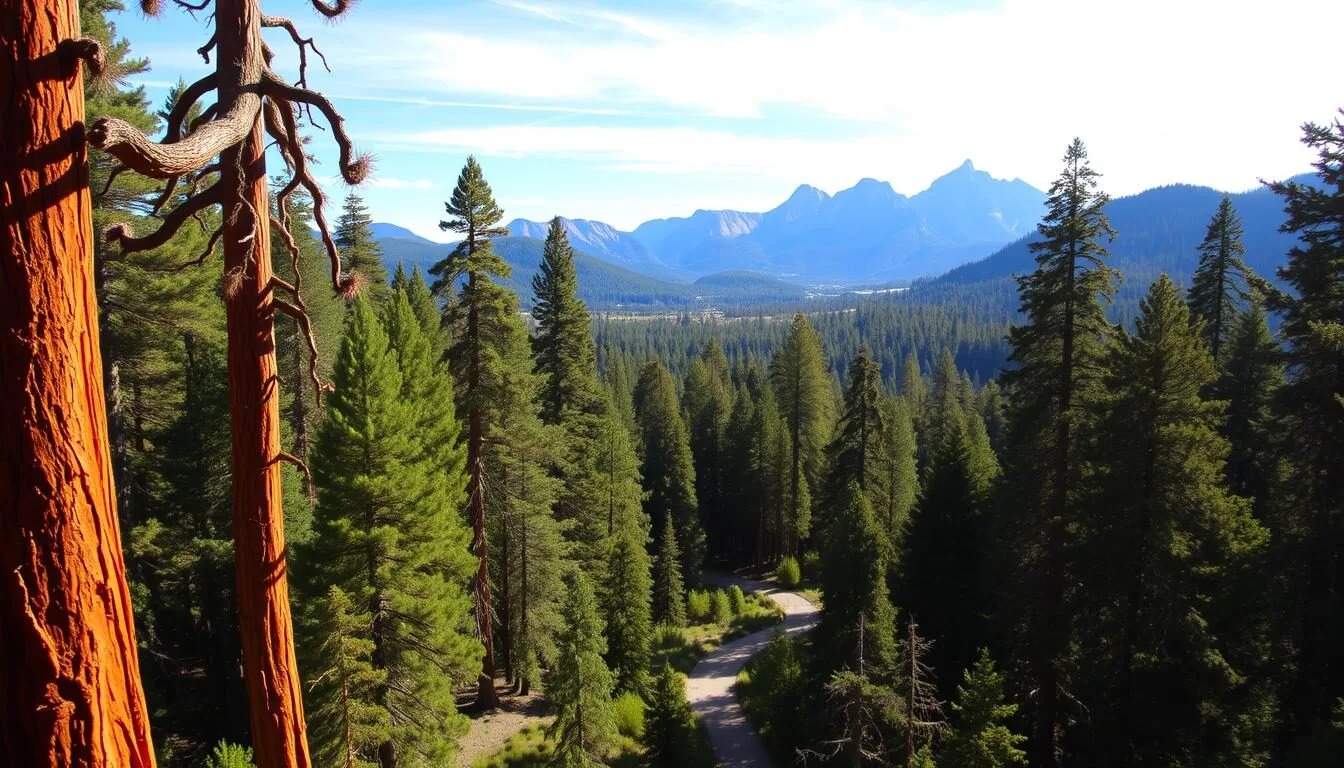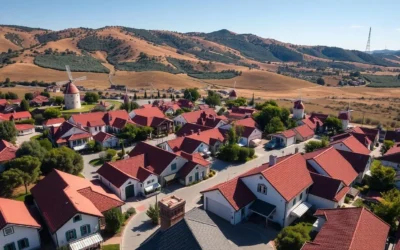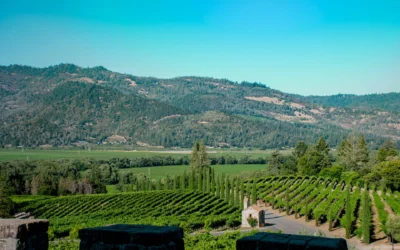Imagine standing beneath the world’s largest trees by volume, surrounded by a breathtaking landscape that spans over 865,000 acres. Sequoia and Kings Canyon National Parks offer an unforgettable experience for nature lovers and adventure seekers alike.
As you plan your visit, get ready to explore the majestic General Sherman Tree, hike along scenic trails with panoramic mountain views, and enjoy the unique charm of each season. Whether you’re planning a day trip or an extended stay, these parks have something to offer for everyone.
With Sequoia National Forest covering an additional 1.1 million acres, the opportunities for exploration are endless. Come and experience the natural beauty of these incredible national parks.
Discovering the Majestic Sequoia Range
The Sequoia Range, encompassing Sequoia and Kings Canyon National Parks, is a haven for nature lovers and adventure seekers. As you explore this region, you’ll discover a diverse landscape that is home to some of the most spectacular natural wonders in the United States.
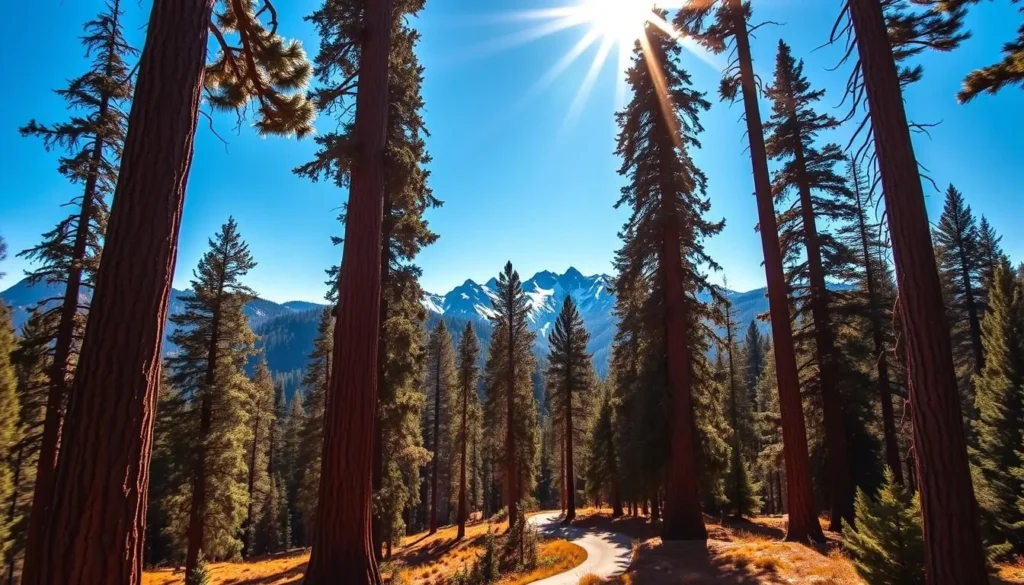
The Sequoia Range is a unique destination that offers a mix of accessibility and rugged wilderness experiences. While Sequoia National Park is known for its iconic attractions like the General Sherman Tree, Kings Canyon National Park provides deeper wilderness experiences and dramatic canyon landscapes.
The Land of Giants: Sequoia and Kings Canyon National Parks
Sequoia and Kings Canyon National Parks together protect over 865,000 acres of pristine wilderness in the southern Sierra Nevada mountains. These connected parks are home to the largest trees on Earth by volume – the giant sequoias – which can live for thousands of years and reach heights of over 250 feet.
| Park Features | Sequoia National Park | Kings Canyon National Park |
|---|---|---|
| Accessibility | More accessible with iconic attractions | Less accessible, ideal for backcountry hiking |
| Landscapes | Iconic giant sequoias, foothills | Dramatic canyon landscapes, alpine peaks |
| Ecosystems | Diverse ecosystems from foothills to giant sequoias | Diverse ecosystems from canyon landscapes to alpine peaks |
Understanding the geography and layout of these parks will help you plan your visit more effectively and ensure you don’t miss the most significant attractions. Both parks are managed as a single unit by the National Park Service, though each maintains its distinct character and natural features.
The diverse ecosystems within these parks range from low-elevation foothills to alpine peaks, supporting an incredible variety of plant and animal life. As you explore the Sequoia Range, you’ll have the opportunity to experience the natural beauty of Sequoia and Kings Canyon National Parks in a way that feels both intimate and awe-inspiring.
The Iconic General Sherman Tree
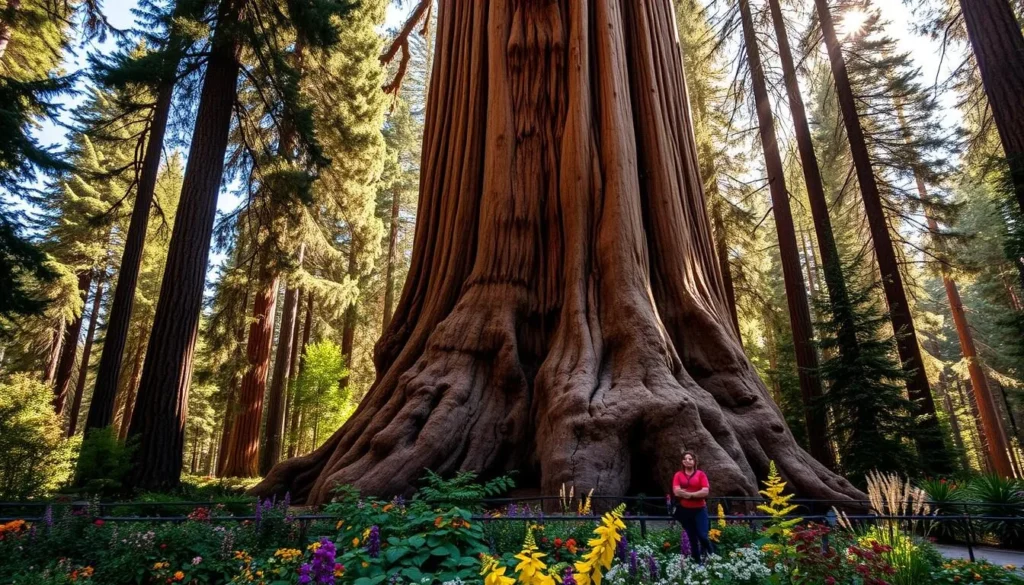
Standing in the shadow of the General Sherman Tree is an awe-inspiring experience that leaves a lasting impression on visitors. As the largest tree in the world by volume, this natural giant is a must-see attraction in Sequoia National Park.
Meeting the World’s Largest Tree
The General Sherman Tree is estimated to be around 3,000 years old, making it one of the oldest living things on Earth. Its sheer size is awe-inspiring: it stands 275 feet tall, with a base diameter of 36 feet. To put that into perspective, it contains enough wood to build around 120 average-sized homes.
To visit the General Sherman Tree, you can take a 1/2-mile trail that descends through a beautiful grove of massive sequoias. The trail is relatively easy, but it does include stairs and a moderate incline on the return journey. Be sure to take your time and use the benches provided to rest and appreciate the surrounding Giant Forest.
- Standing at the base of the General Sherman Tree is a humbling experience that puts human existence into perspective – this living giant has been growing for approximately 3,000 years.
- As the world’s largest tree by volume, the General Sherman measures 275 feet tall with a base diameter of 36 feet, containing enough wood to build 120 average-sized homes.
- The trail to reach this magnificent specimen descends through a beautiful grove of massive sequoias, offering plenty of photo opportunities along the way.
- While not the tallest tree in the world (that honor belongs to coastal redwoods), the General Sherman is taller than the Statue of Liberty, making it an impressive sight to behold.
- The 1/2-mile trail to the tree includes stairs and a moderate incline on the return journey, so take your time and use the benches provided to rest and appreciate the surrounding forest.
- During peak season, this is one of the busiest attractions in the park, so consider visiting early in the morning or later in the afternoon to avoid the largest crowds.
- Remember to look up and around as you approach – the sheer scale of the General Sherman is difficult to capture in photographs, and the surrounding Giant Forest is equally impressive.
Visiting the General Sherman Tree is an unforgettable experience that allows you to connect with nature on a profound level. As you stand before this natural wonder, you can’t help but feel a sense of awe and reverence for the natural world.
Exploring the Congress Trail
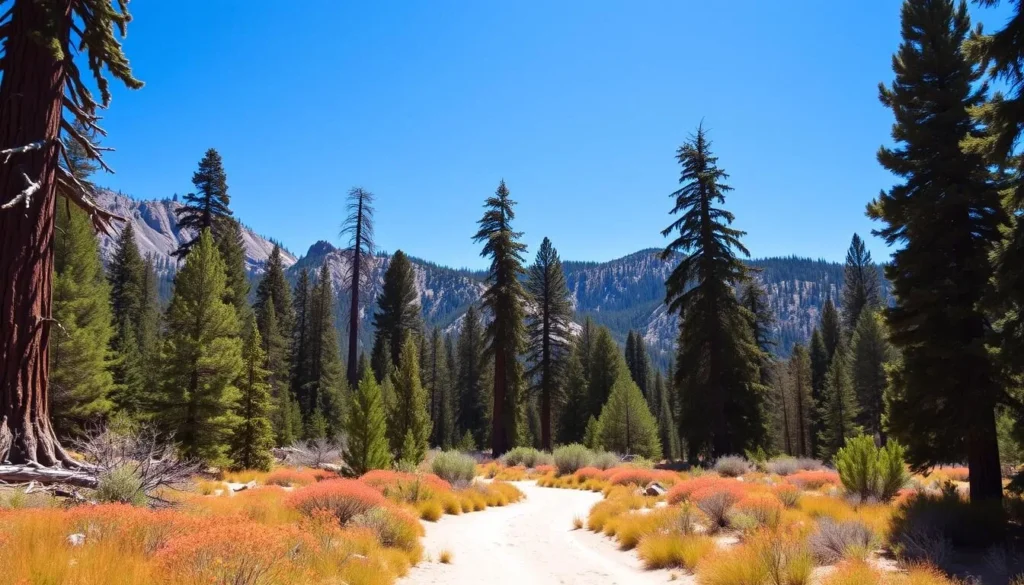
The Congress Trail, starting near the iconic General Sherman Tree, is a relatively flat and easy-to-navigate path that winds through a stunning collection of sequoia trees. This 2.9-mile loop is considered one of the best trails in Sequoia National Park for day hiking, offering an intimate experience among the giants with minimal elevation gain.
As you stroll along the Congress Trail, you’ll encounter clusters of massive trees named after political figures and institutions, including The President, The Senate, and The House. These named tree clusters offer unique formations and photo opportunities that capture the essence of the Giant Forest. The trail is well-maintained and clearly marked, with interpretive signs providing fascinating information about sequoia ecology and the history of the forest.
Walking Among Giants: The President and Senate Trees
One of the highlights of the Congress Trail is the opportunity to walk among some of the most impressive trees in the park, including The President and The Senate. These trees are not only remarkable for their size but also for their historical significance, being named after prominent political figures. As you walk among these giants, you’ll be struck by their majesty and the serene atmosphere of the forest.
The President and Senate Trees are particularly noteworthy, offering a glimpse into the natural and cultural history of the area. The Congress Trail provides a unique chance to experience these incredible trees up close, making for a memorable and enriching visit to Sequoia National Park.
Whether you’re a nature enthusiast, a photographer, or simply looking for a peaceful hike, the Congress Trail is an excellent choice. With its relatively flat terrain and stunning scenery, it’s an ideal trail for visitors of all ages and abilities. Allow approximately 1.5-2 hours to complete the full loop, though you might want to budget more time for photography and peaceful contemplation among these ancient beings.
Climbing Moro Rock for Panoramic Views
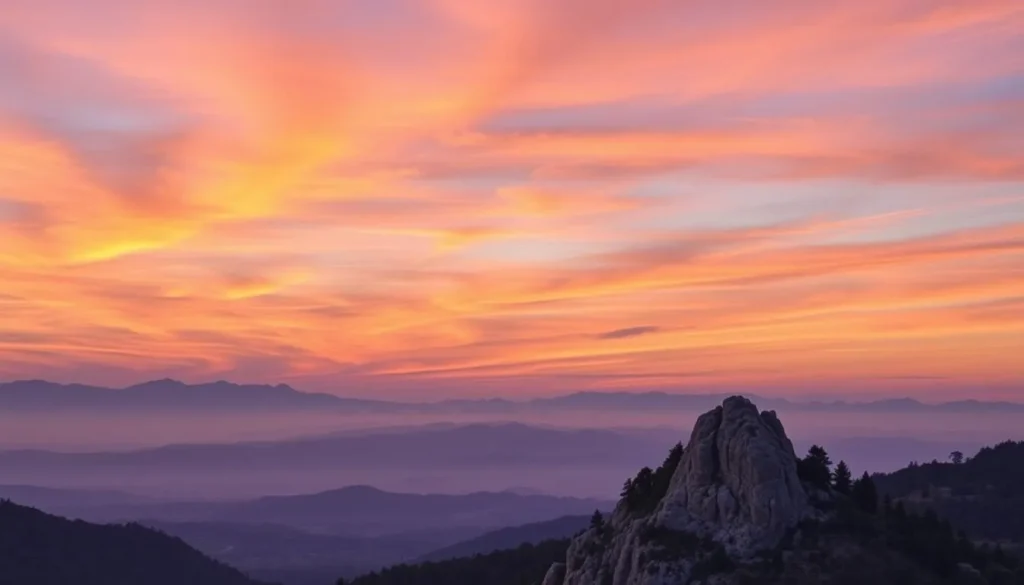
As you venture into the heart of Sequoia National Park, the allure of Moro Rock beckons with its promise of breathtaking vistas. This granite dome is a must-visit attraction, offering panoramic views that are simply unmatched.
The 350-Step Adventure to the Summit
The trail to the summit of Moro Rock is an adventure in itself, comprising approximately 350 steps carved into the rock face. This stairway ascends about 300 feet from the base to the top, providing a challenging yet rewarding hike. While the distance is relatively short, at about 0.3 miles one-way, the steep ascent and high elevation (over 6,700 feet) demand a moderate level of fitness.
As you climb, the narrow path and significant drop-offs require caution, especially when accompanied by kids. It’s essential to keep young ones close and hold their hands in the most exposed areas.
Safety Tips for Families with Children
Visiting Moro Rock with children can be a wonderful experience, provided you take necessary precautions. The trail can be narrow and steep, so it’s crucial to be mindful of your children’s safety. Always keep them close and be prepared for slow going during peak season due to the single-file nature of the trail.
Alternative Viewpoints: Hanging Rock and Eagle View
If the crowds or the steepness of Moro Rock are a concern, consider alternative viewpoints such as Hanging Rock or Eagle View. Hanging Rock is a short diversion from the Moro Rock Trail and offers beautiful views without the crowds. Similarly, Eagle View Trail near Crescent Meadow provides another vantage point to enjoy the scenery.
For those planning to visit during summer months, be aware that the road to Moro Rock is closed to private vehicles on weekends. You’ll need to use the park shuttle system from Giant Forest Museum or hike the approximately 2-mile trail from the museum.
Crescent Meadow and Tharp’s Log
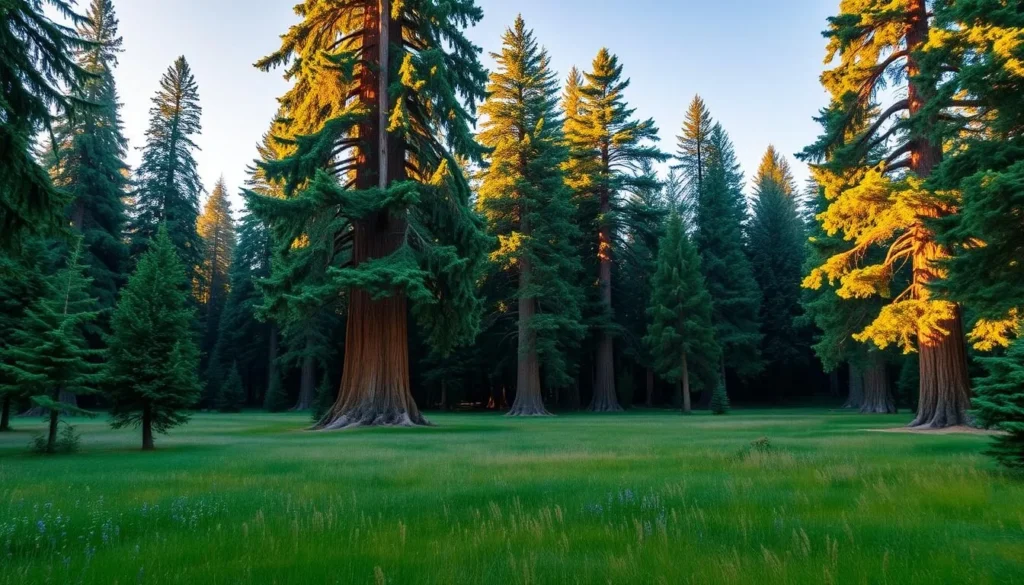
As you explore the natural wonders of Sequoia National Park, Crescent Meadow is a must-visit destination. This picturesque meadow, surrounded by towering sequoias, offers a serene and unforgettable experience. The Crescent Meadow Loop Trail is a 1.5-mile, relatively flat hike that’s perfect for families and visitors of all ages.
The “Gem of the Sierra” Experience
Crescent Meadow, famously described by John Muir as the “Gem of the Sierra,” is a lush, flower-filled meadow that creates one of the most picturesque settings in the park. The vibrant wildflower displays in late spring and early summer transform the meadow into a colorful tapestry, adding another dimension to this already magical setting. For photographers, the interplay of light and shadow across the meadow, especially during golden hour, creates stunning opportunities for capturing the essence of the Sierra Nevada landscape.
Discovering Tharp’s Log: A Piece of History
Along the Crescent Meadow Trail, you’ll discover Tharp’s Log, a unique historic cabin fashioned from a fallen sequoia log by Hale Tharp in 1861. This cabin served as Tharp’s summer shelter and later hosted John Muir during his explorations of the area. The idea of living in a log is truly staggering, and it’s amazing that this historic site has been preserved.
Wildlife Watching Opportunities
The meadow and surrounding forest are prime locations for wildlife viewing, particularly in the early morning or late afternoon when black bears are frequently spotted foraging in the meadow. Always maintain a safe distance and make noise while hiking to avoid surprising animals. The trail is also home to various other wildlife, making every hike a unique adventure.
The trail connects to several other paths in the area, allowing you to extend your adventure to nearby attractions like Log Meadow or the Trail of the Sequoias for those wanting a longer hike. Whether you’re interested in history, wildlife, or simply enjoying the beauty of nature, Crescent Meadow and Tharp’s Log offer an unforgettable experience.
Driving Through Tunnel Log
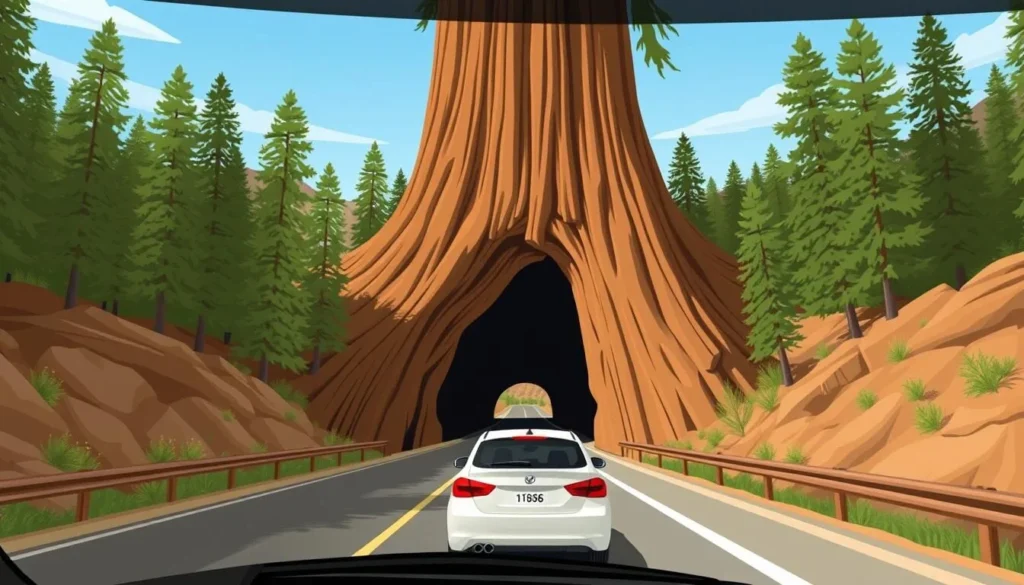
Tunnel Log in Sequoia National Park offers an unforgettable experience, allowing visitors to drive through a fallen giant sequoia. Created in 1937 when a massive sequoia fell across the road, park officials decided to carve a tunnel through it rather than remove the tree, resulting in this unique attraction that stands 8 feet high and 17 feet wide.
A Unique Photo Opportunity
Tunnel Log is one of the most iconic photo opportunities in Sequoia National Park. To capture the best photos, visit early in the morning or later in the evening to avoid other vehicles. The tunnel is 8 feet high, so ensure your vehicle can fit through before attempting to drive it. Not all vehicles can fit through the tunnel – larger SUVs, vans, and RVs may be too tall for the 8-foot clearance.
Seasonal Access Information
Seasonal access to Tunnel Log varies throughout the year. During winter and early spring, the road to Tunnel Log is typically closed to vehicles. However, this creates a special opportunity to walk through the log instead. You can access Tunnel Log by hiking approximately 1.5 miles one-way from the Giant Forest Museum along connecting trails. When the road is closed or shuttle waits are long, this trail provides a great alternative to experience Tunnel Log.
Plan your visit according to the time of year and check the park’s access information to make the most of your trip. Whether you drive or walk through Tunnel Log, it’s an experience you’ll never forget in Sequoia National Park.
Hiking the Big Trees Trail
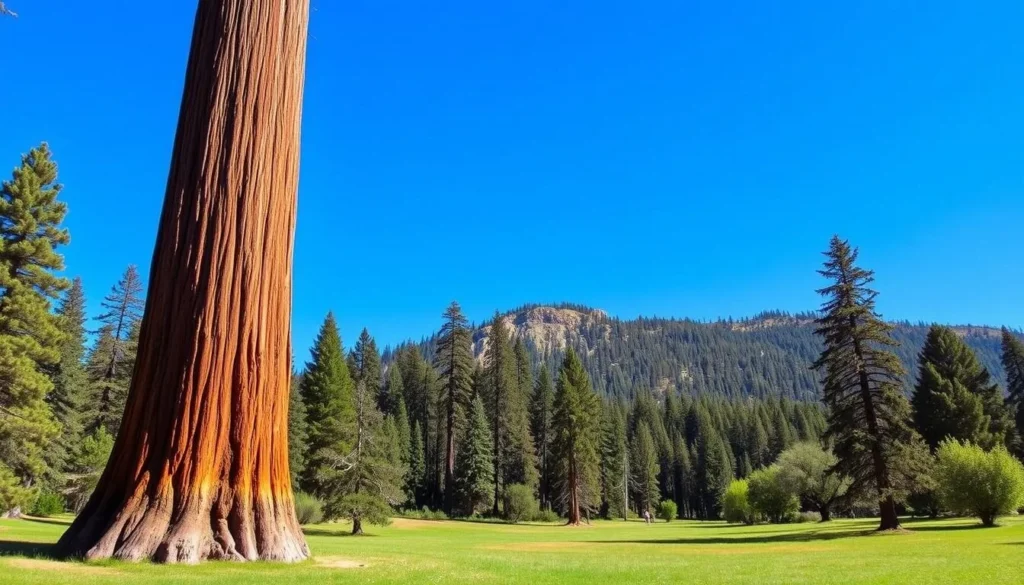
As you step into the Giant Forest, the Big Trees Trail awaits, offering an unforgettable journey among the world’s largest trees. This 1.4-mile paved loop is designed to be accessible for everyone, including families with young children and visitors with mobility challenges.
An Educational Walk Through Round Meadow
The Big Trees Trail is not just a hike; it’s an educational experience. Starting from the Giant Forest Museum, the trail features interpretive signage that explains the unique ecology of the giant sequoias, their relationship with fire, and the conditions that allow these giants to thrive. As you walk, you’ll encounter numerous massive sequoias, including the Sentinel Tree, which stands over 257 feet tall and is estimated to be more than 2,100 years old.
Family-Friendly Features Along the Trail
The trail is full of natural features that kids will love, such as fallen logs to climb on and hollow trees to explore. The meadow setting also provides excellent opportunities to spot wildlife, especially during early morning or evening hours when deer and various bird species are most active.
For the best experience, park at the Giant Forest Museum parking lot and begin your hike from there. This also gives you the chance to visit the museum when it’s open to learn more about the sequoia ecosystem. Whether you’re hiking with kids or simply looking for a leisurely walk, the Big Trees Trail is a must-visit destination in Sequoia National Park.
Tokopah Falls Trail: A Riverside Adventure
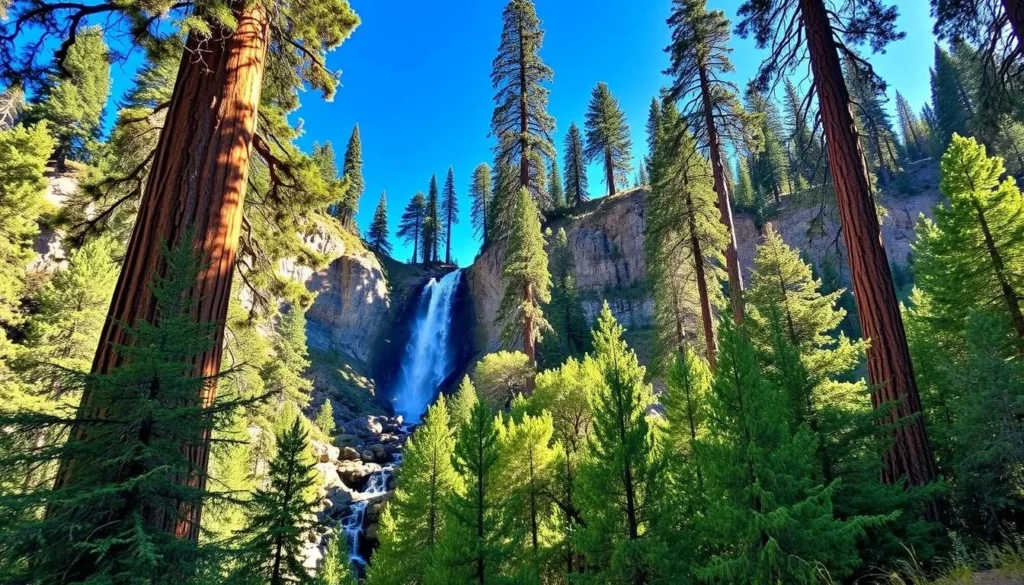
The Tokopah Falls Trail in Sequoia National Park is a hidden gem for hikers. This moderately easy 3.4-mile round-trip hike follows the Marble Fork of the Kaweah River through a stunning glacial canyon to a 1,200-foot cascading waterfall.
Following the Kaweah River
As you embark on the Tokopah Falls Trail, you’ll begin near the Lodgepole Campground and follow the Marble Fork of the Kaweah River. The trail stays close to the river for most of its length, offering numerous spots to stop and enjoy the crystal-clear water. The scenery is characterized by towering granite cliffs and lush riverside vegetation, making it a perfect hike during hot summer days when other exposed trails might be uncomfortably warm.
The trail is shaded for much of the walk, providing relief from the summer sun. Along the way, you can explore the river and its many pools, making it an ideal hike for families.
What to Expect at the Waterfall
As you approach the final quarter-mile of the trail, the path becomes more challenging as it navigates over granite boulders. However, the effort is rewarded with dramatic views of Tokopah Falls cascading down the cliff face. The waterfall is most impressive in late spring and early summer when snowmelt creates a powerful flow, though it remains a beautiful destination even in late summer when the water volume decreases.
The end of the trail offers amazing views of the falls, the canyon, and the valley, all carved by the water. You can set up a blanket and have a dip in the cool water at several spots along the trail.
Sequoia Range, California: Best Things to Do – Top Picks in Kings Canyon
Kings Canyon National Park is a must-visit destination, providing a different yet equally magnificent experience compared to Sequoia National Park. The park boasts a dramatic deep canyon, rushing rivers, and a more remote wilderness feel, making it an ideal location for those seeking adventure and natural beauty.
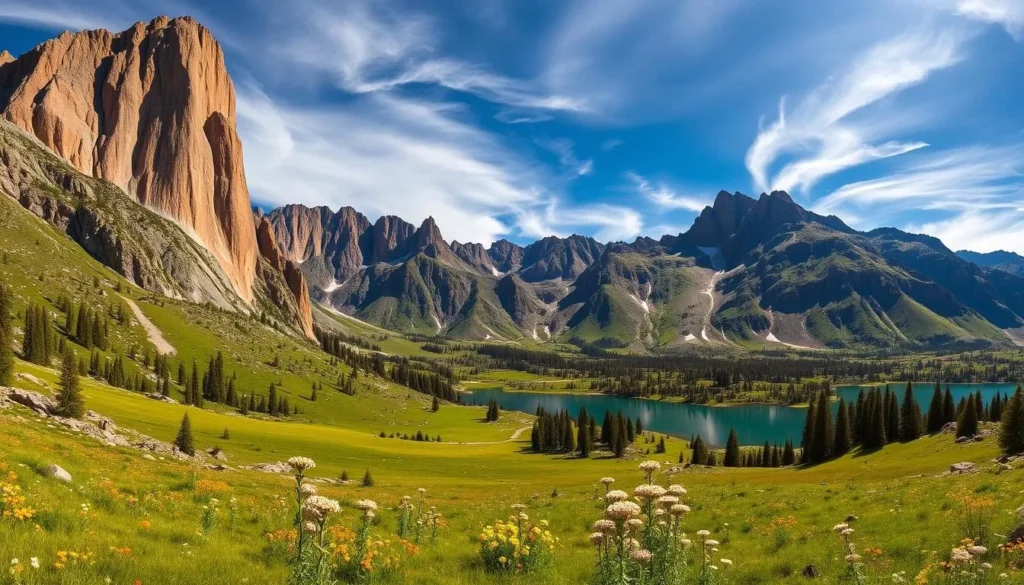
Kings Canyon Scenic Byway: A Spectacular Drive
The Kings Canyon Scenic Byway (Highway 180) is one of California’s most spectacular drives, winding 28 miles from Grant Grove to Cedar Grove. This scenic drive offers breathtaking vistas at nearly every turn, with steep canyon walls that showcase the natural grandeur of the area. As you drive along this byway, be sure to stop at the various viewpoints to take in the stunning scenery.
Grant Grove and the General Grant Tree
Grant Grove is home to the General Grant Tree, the second-largest tree in the world. This area is similar to General Sherman in that it has nicely paved walking paths through a gorgeous grove of giant trees. The General Grant Tree Trail is a gentle 0.7-mile loop that takes you through a magnificent grove of sequoias, including the opportunity to walk through a fallen sequoia log.
Zumwalt Meadow Loop Trail
The Zumwalt Meadow Loop Trail is a 1.5-mile loop that offers one of the most accessible and beautiful experiences at the bottom of Kings Canyon. The trail features a stunning suspension bridge crossing the Kings River and dramatic views of towering granite cliffs. This area is particularly beautiful in late spring when wildflowers bloom, and it provides excellent opportunities for wildlife viewing.
In summary, Kings Canyon National Park offers a unique blend of natural beauty and adventure, with attractions like the Kings Canyon Scenic Byway, Grant Grove, and Zumwalt Meadow Loop Trail. Whether you’re driving through the scenic byway, exploring the giant trees, or hiking through the meadows, Kings Canyon is a destination that promises an unforgettable experience.
Roaring River Falls and Mist Falls
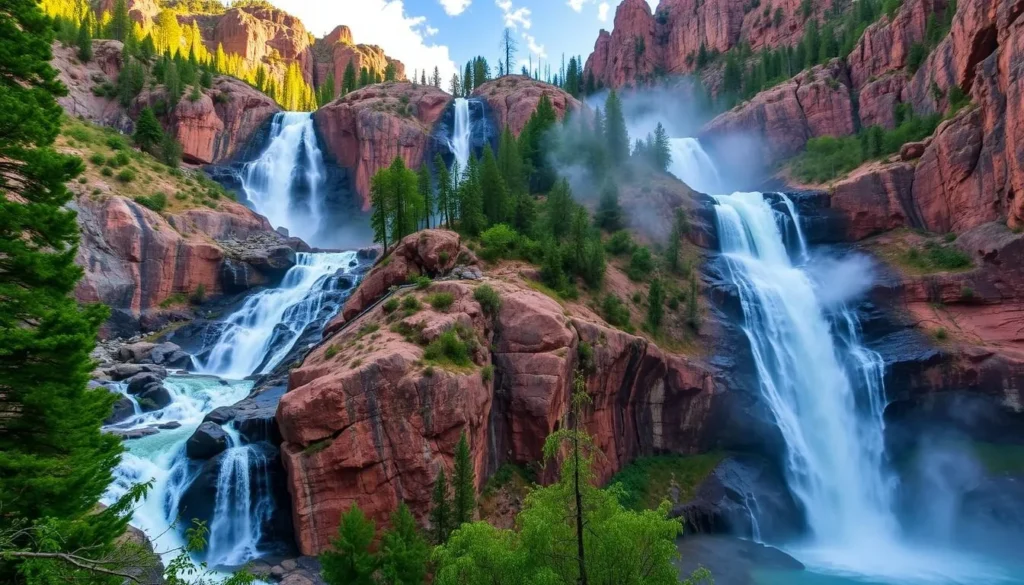
Roaring River Falls and Mist Falls are must-see attractions in Kings Canyon, showcasing the park’s natural splendor. Both waterfalls offer a unique experience, with Roaring River Falls being easily accessible and Mist Falls requiring a more substantial hike.
Easy Access to Roaring River Falls
Roaring River Falls is a short, 0.2-mile paved trail that leads to a powerful waterfall. The accessibility of this trail makes it perfect for visitors with limited time or mobility challenges. The waterfall thunders through a narrow granite chute, creating an impressive display of nature’s force. You can feel the power of the water as you stand near the falls, making it a memorable experience.
The trail is well-maintained and suitable for families with children. Even with minimal elevation change, the scenery is breathtaking, and the roar of the water is almost deafening. Roaring River Falls maintains an impressive volume throughout most of the year, making it a great spot for photography, especially during late spring and early summer when snowmelt increases water flow.
The Rewarding Hike to Mist Falls
In contrast, Mist Falls requires an 8-mile round-trip hike that follows the South Fork of the Kings River. The trail begins at Road’s End in Cedar Grove and offers diverse scenery along its length, from river views to forest sections. As you hike, you’ll be treated to the sounds of the river and the beauty of the surrounding landscape. The hike gradually climbs about 800 feet in elevation to reach the spectacular cascade.
Mist Falls creates a refreshing mist on hot summer days, hence the name. The waterfall is surrounded by a lush environment, making it a perfect spot for a picnic or simply to enjoy the scenery. The hike is considered one of the most beautiful day hikes in the Cedar Grove District of Kings Canyon National Park, offering varied compositional opportunities for photographers with its wider cascade and surrounding landscape.
Off the Beaten Path Adventures
For those seeking adventure beyond the usual tourist trails, Sequoia and Kings Canyon offer a plethora of hidden gems waiting to be discovered. These lesser-known trails provide a unique opportunity to experience the natural beauty and rich history of the parks without the crowds.
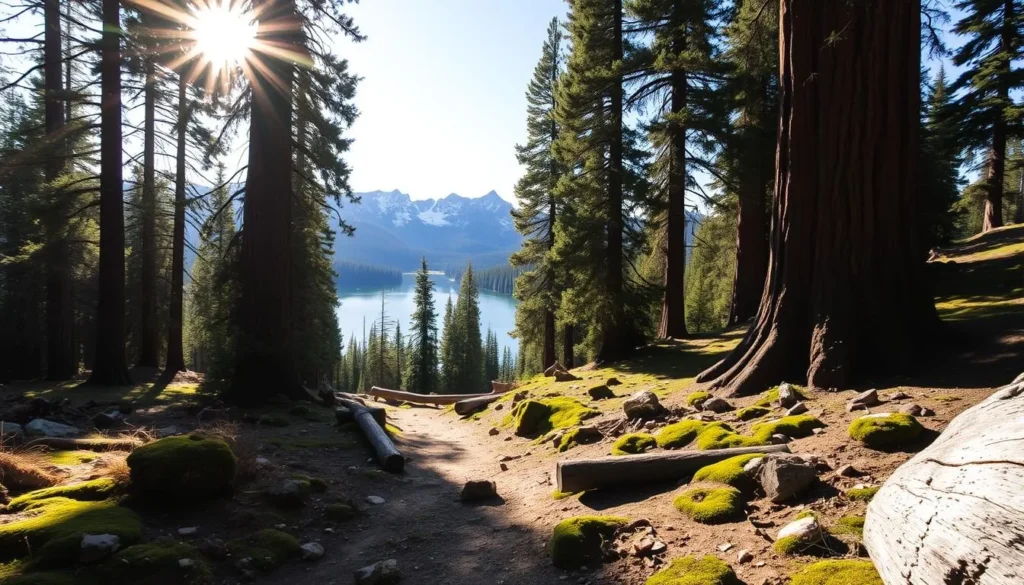
Little Baldy Trail for Sunrise and Sunset
The Little Baldy Trail is a hidden gem that offers breathtaking 360-degree views of the surrounding mountains and valleys. This 3.4-mile round-trip hike is relatively easy and is ideal for both sunrise and sunset photography. The granite dome at the summit is a perfect spot to watch the sky change colors, making it a photographer’s paradise.
Big Stump Trail: A Historical Perspective
The Big Stump Loop Trail provides a sobering historical perspective on the logging that once took place in the Sierra Nevada. This 2.2-mile loop trail features massive stumps of sequoias that were cut down before the area was protected, including the famous Mark Twain Stump. The trail offers a glimpse into the past, highlighting the importance of conservation efforts.
Don Cecil Trail to Lookout Peak
For experienced hikers, the Don Cecil Trail to Lookout Peak offers a challenging 11.2-mile out-and-back hike with panoramic views from the summit. The trail climbs from the Kings Canyon floor to Lookout Peak, which sits just outside the park boundary in the Sequoia National Forest. The dramatic elevation change and diverse plant communities make this trail a unique adventure.
These off-the-beaten-path trails offer more than just scenic views; they provide a chance to connect with nature and experience the rich cultural and natural history of Sequoia and Kings Canyon. Whether you’re a seasoned hiker or just looking for a new adventure, these trails are sure to leave a lasting impression.
- The Little Baldy Trail leads to a granite dome with spectacular views, making it ideal for sunrise and sunset photography.
- Big Stump Trail features massive stumps of sequoias, providing a historical perspective on logging in the Sierra Nevada.
- The Don Cecil Trail to Lookout Peak offers a challenging hike with panoramic views from the summit.
- These trails are less crowded than popular attractions, allowing for a more peaceful experience and better wildlife viewing opportunities.
- Each trail showcases a different ecosystem within the parks, from mixed conifer forests to historic logging areas.
Crystal Cave: Underground Wonders
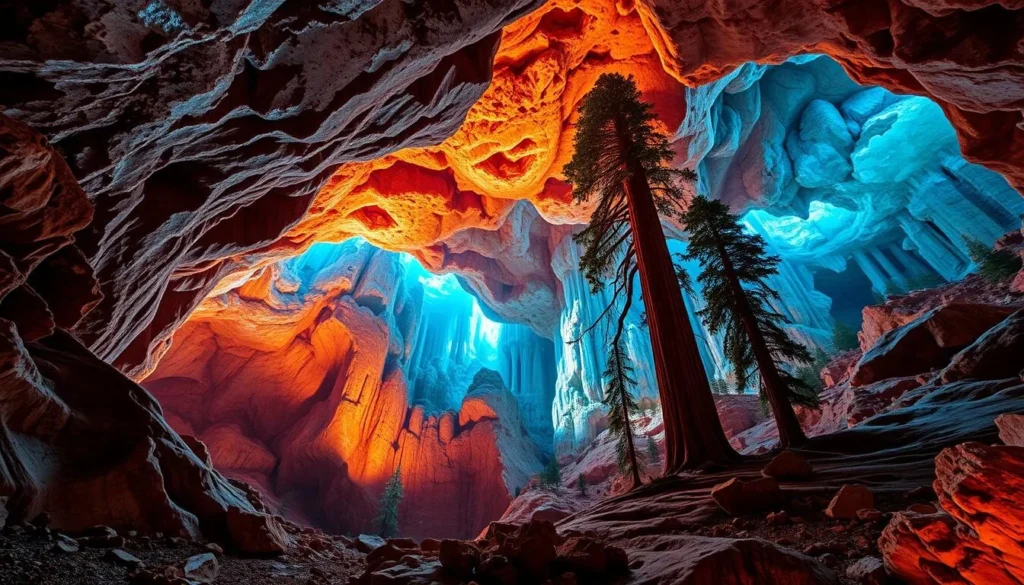
Explore the hidden wonders of Crystal Cave, a marvel within Sequoia National Park. Crystal Cave offers a unique perspective on the park, taking visitors underground to explore a marble karst cavern adorned with stalactites, stalagmites, and flowing stone formations.
The cave is only accessible through guided tours operated by the Sequoia Parks Conservancy, which typically last about 50 minutes and cover a half-mile of cave passages. This guided tour experience provides insights into the cave’s formation, its unique ecosystem, and conservation efforts to protect this delicate environment.
Guided Tour Experience
The guided tour is an educational experience that highlights the natural and historical significance of Crystal Cave. Tours are available for all ages and are limited to 25 people per group, ensuring an intimate experience.
The cave maintains a constant cool temperature of around 50°F (10°C), making it a refreshing escape on hot summer days. However, visitors are advised to bring a light jacket as it can be cool inside the cave.
Booking Tips and Seasonal Information
To visit Crystal Cave, it’s essential to book tickets in advance as tours frequently sell out weeks in advance during peak summer season. Tickets can be purchased through the Sequoia Parks Conservancy website or at visitor centers.
Crystal Cave is open from late May through September. The cave is closed during winter months due to access issues and for the protection of the bats that hibernate there. Planning your visit during the open season ensures a memorable experience.
Wildlife Encounters: Bears and More
As you explore the Sequoia and Kings Canyon National Parks, be prepared for unforgettable wildlife encounters. The parks are home to a diverse range of animals, including the iconic American black bear.
Bear Safety in Sequoia and Kings Canyon
Encountering bears can be a thrilling experience, but safety should always be your top priority. The Sequoia and Kings Canyon National Parks are home to approximately 300-500 American black bears. To ensure a safe visit, it’s crucial to follow bear safety guidelines.
- Always store food properly in designated bear-proof containers or lockers.
- Never leave food unattended, even for a moment.
- Keep a clean campsite free of food odors.
- If you encounter a bear on the trail, remain calm, make yourself look larger, and slowly back away.
By taking these precautions, you can minimize the risk of a bear encounter gone wrong. Remember, bears are wild animals that deserve respect and distance.
| Bear Safety Tips | Description |
|---|---|
| Store Food Properly | Use bear-proof containers or lockers. |
| Keep a Clean Campsite | Free of food odors and trash. |
| React Calmly to Bears | Make yourself look larger and back away slowly. |
Other Wildlife to Watch For
Beyond bears, the Sequoia and Kings Canyon National Parks host a wide variety of wildlife. You can spot mule deer grazing in meadows, bobcats roaming through forests, and over 200 species of birds flying overhead.
The best times for wildlife viewing are during dawn and dusk when animals are most active. Meadows like Crescent Meadow and Zumwalt Meadow are particularly good spots for sightings.
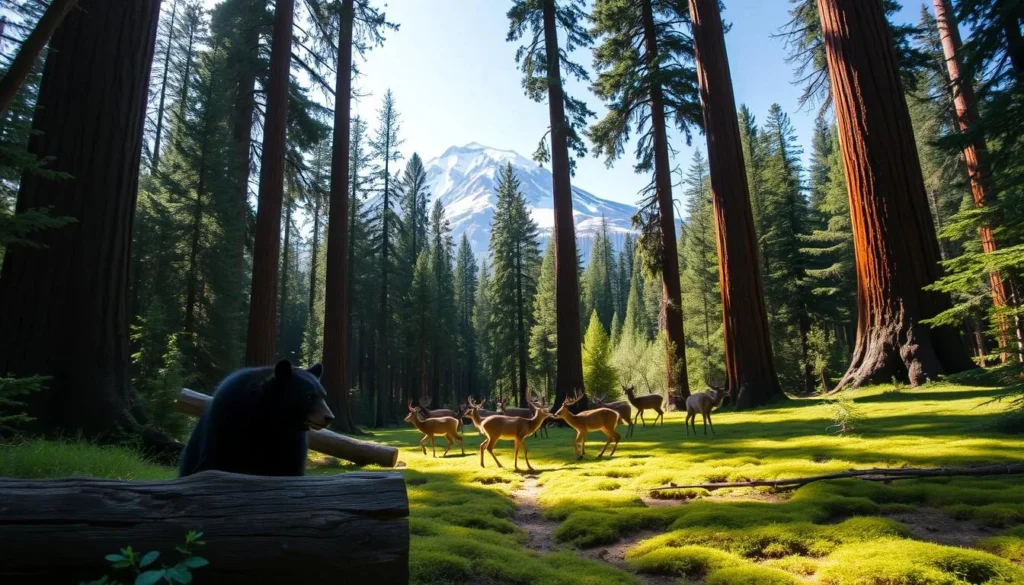
As you explore the parks, keep an eye out for other fascinating creatures, including yellow-bellied marmots, pikas, and bighorn sheep in the alpine regions, and California ground squirrels and western fence lizards in the foothills.
Where to Stay in and Around the Parks
When planning your trip to Sequoia and Kings Canyon National Parks, choosing the right accommodation is crucial for a memorable experience. The parks offer a range of options to suit different needs and preferences.
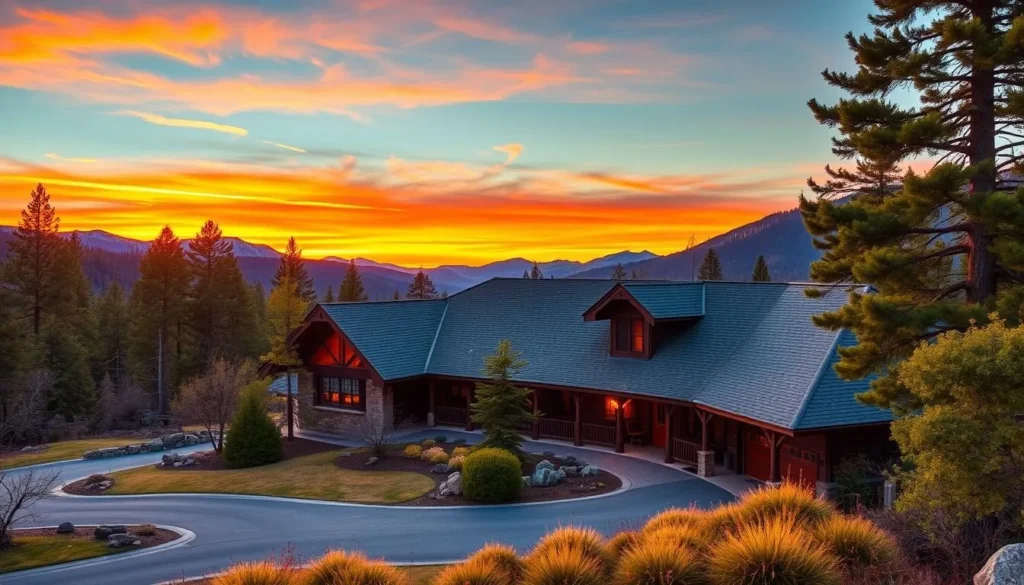
In-Park Lodging Options
The John Muir Lodge in Grant Grove is highly recommended for its central location, providing easy access to both Sequoia and Kings Canyon National Parks. For those looking to experience the remote beauty of Kings Canyon, the Cedar Grove Lodge is the only in-park lodging at the bottom of the canyon, offering unparalleled access to attractions like Roaring River Falls and Zumwalt Meadow.
Wuksachi Lodge in Sequoia National Park provides modern accommodations surrounded by sequoia groves and mountain views, along with a restaurant and a central location for exploring the Giant Forest area.
Campgrounds for Nature Lovers
For nature enthusiasts, Sequoia and Kings Canyon have 14 campgrounds with varying amenities and seasonal availability. Popular options include Lodgepole Campground near the Giant Forest, Azalea Campground in Grant Grove, and Sentinel Campground in Cedar Grove.
These campgrounds are popular, so it’s essential to make reservations in advance, especially during the peak summer season.
Nearby Accommodations
For those who prefer to stay outside the parks, the towns of Three Rivers near Sequoia and Fresno or Visalia near Kings Canyon offer additional accommodation options, ranging from budget motels to upscale resorts.
Regardless of where you choose to stay, reservations are strongly recommended, especially during peak season when both in-park lodging and campgrounds frequently book up months in advance.
Practical Tips for Visiting Sequoia and Kings Canyon
Before you head to Sequoia and Kings Canyon, it’s essential to plan ahead. With over 1.2 million visitors annually, these parks can be quite crowded, and a little preparation can go a long way in making your trip enjoyable.
Navigating the Parks: Shuttle System and Driving
Navigating Sequoia and Kings Canyon is part of the adventure. During the summer, a free shuttle system operates in Sequoia National Park, making it easier to get to popular spots like Moro Rock and the General Sherman Tree without the hassle of parking. However, be prepared for winding mountain roads with speed limits of 25-35 mph. The drive from the southern entrance of Sequoia to the Cedar Grove area of Kings Canyon can take around 2.5-3 hours without stops. So, plan your day accordingly, and consider using the shuttle to reduce traffic congestion.
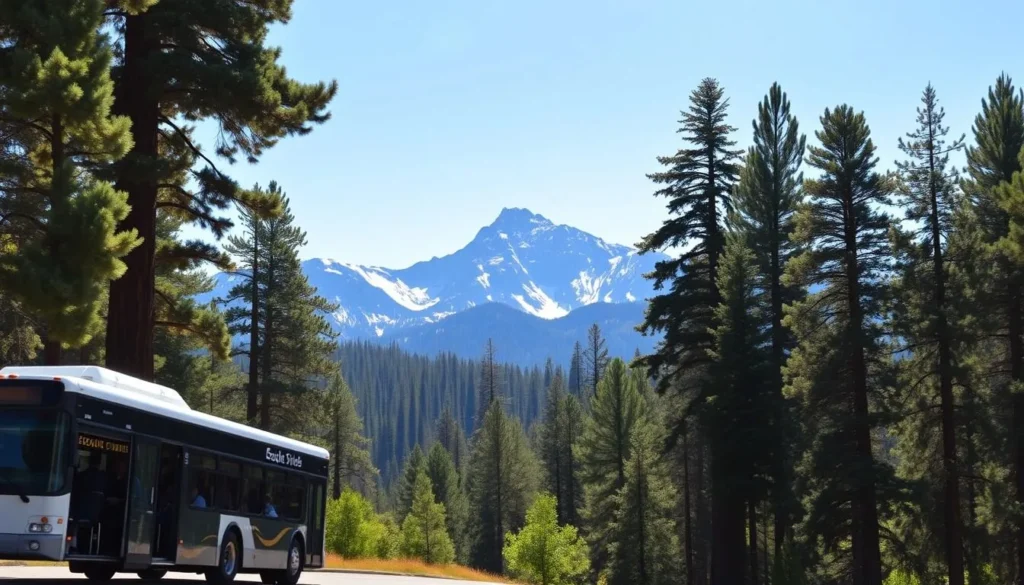
Best Times to Visit Popular Attractions
To avoid the crowds, it’s a good idea to visit popular attractions like the General Sherman Tree and Giant Forest areas early in the morning (before 9 AM) or late in the afternoon (after 4 PM). These times not only help you avoid the peak tourist hours but also make it easier to find parking. Planning your visit around these times can significantly enhance your experience.
What to Pack for Your Adventure
Packing the right gear is crucial for a comfortable and enjoyable trip. Make sure to bring layers of clothing as temperatures can vary significantly with elevation. Don’t forget sun protection, plenty of water (at least 2 liters per person per day), and snacks. A detailed park map is also a must, as cell service is limited throughout the parks. Lastly, ensure your vehicle has a full tank of gas, as there are no gas stations within the parks.
By planning ahead, using the shuttle system, visiting at the right times, and packing appropriately, you can have a memorable and enjoyable visit to Sequoia and Kings Canyon National Parks.
Conclusion: Making the Most of Your Sequoia Range Adventure
With its awe-inspiring landscapes, Sequoia Range is a must-visit destination for nature lovers and adventure seekers alike. As you explore Sequoia and Kings Canyon National Parks, you’ll be surrounded by the world’s largest trees, deep canyons, and alpine meadows, showcasing the incredible diversity of the Sierra Nevada mountains.
More than 80% of visitors to these parks take a day trip, often on their way to or from Yosemite. While there’s much to see, focusing on one area, such as the Giant Forest near the Foothills Visitor Center or the Giant Forest Museum, can make for a more meaningful experience. This approach allows you to appreciate the giant sequoias without feeling rushed.
The experience of standing among these ancient giants, which have witnessed thousands of years of history, creates memories that last a lifetime. Whether you’ve spent a day or a week exploring the parks, the changing seasons offer different perspectives – from the full access of summer to the serene landscapes of winter.
- The Sequoia Range offers breathtaking natural wonders, from the world’s largest trees to deep canyons and alpine meadows.
- Focusing on one section of the parks allows for a more meaningful experience, especially for those with limited time.
- Beyond iconic attractions, lesser-known trails and viewpoints often provide the most memorable connections with the landscape.
- The preservation of these sequoia groves is one of America’s greatest conservation successes, protecting ancient trees from logging.
- Consider supporting ongoing conservation efforts to ensure these natural treasures remain protected for future generations.
As you leave the Sequoia Range, reflect on the experience and the importance of preserving these natural wonders. By supporting conservation efforts, you can help ensure that Sequoia and Kings Canyon National Parks continue to thrive for years to come.
